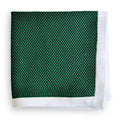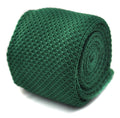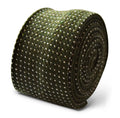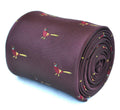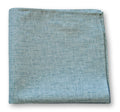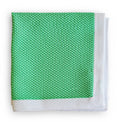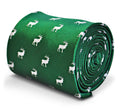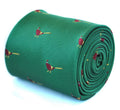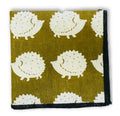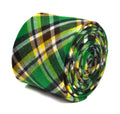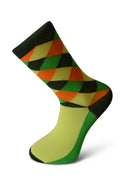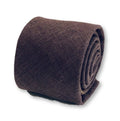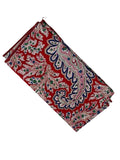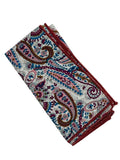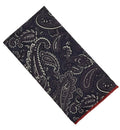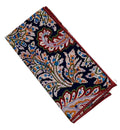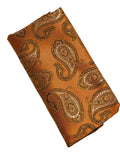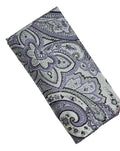Mastering the Modern Necktie: A Comprehensive Style Guide
Posted by FREDERICK THOMAS HANDMADE MENS TIES

The Enduring Elegance of the Necktie
For centuries, the necktie has been a cornerstone of professional and formal attire, symbolizing sophistication, attention to detail, and personal style. Yet, many find themselves at a loss when it comes to selecting the right tie, tying it correctly, or matching it with their outfits. This comprehensive necktie guide aims to demystify the art of tie-wearing, providing you with the knowledge to elevate your wardrobe and make a lasting impression.
Whether you're new to the world of neckties or looking to refine your existing skills, understanding the nuances of fabric, pattern, and proportion is crucial. We'll explore everything from how to tie a tie to choosing the perfect accessory for any event.
Understanding Tie Length and Width: The Foundations of Fit
Before diving into knots and patterns, it's essential to understand the correct tie length and width. A well-proportioned tie can make all the difference in your overall appearance. Generally, the tip of your tie should fall right at or just above your belt buckle. Any longer or shorter, and it can throw off your entire silhouette.
- Standard Length: Most ties are around 57-58 inches (145-147 cm) long, suitable for men of average height. Taller individuals may need longer ties.
- Standard Width: The typical width for modern ties ranges from 2.5 to 3.25 inches (6.35 to 8.25 cm) at its widest point. Slimmer ties (under 2.5 inches) are more contemporary and often suit slender builds, while wider ties (over 3.25 inches) lean towards a more traditional or classic aesthetic. Always match your tie's width to your lapel's width for a cohesive look.
Mastering Common Tie Knots for Every Occasion
Knowing how to tie a tie properly is fundamental. While there are numerous knots, mastering a few key ones will prepare you for any situation. Each knot offers a distinct look and suits different collar types.
- The Four-in-Hand Knot: The simplest and most versatile knot, perfect for most occasions and collar types. It creates a slightly asymmetrical, slender knot.
- The Half Windsor Knot: A medium-sized, symmetrical knot that is more substantial than the Four-in-Hand but less bulky than the Full Windsor. Ideal for standard spread collars.
- The Full Windsor Knot: A large, triangular, and very symmetrical knot that exudes formality. Best reserved for wide spread collars and significant events.
Practice these knots in front of a mirror until you can tie them with ease. Remember, the goal is a neat, firm knot that sits snugly against your collar.
Exploring Necktie Fabrics and Their Impact
The fabric of your necktie plays a significant role in its drape, texture, and how it interacts with light. Different necktie fabrics are suited for various seasons and occasions.
- Silk: The most classic and versatile tie fabric. Silk ties offer a luxurious sheen and smooth drape, suitable for both formal and business settings.
- Wool/Tweed: Ideal for colder months, these fabrics provide texture and a more casual, rustic feel. They pair well with tweed jackets or flannel suits.
- Linen/Cotton: Lighter and more breathable, perfect for spring and summer. They offer a relaxed, matte finish and are great for smart-casual outfits.
- Knitted Ties: Distinct for their squared-off ends and unique texture, knitted ties are a fantastic way to add a touch of personality and casual elegance to an outfit. They often come in silk or wool.
Decoding Tie Patterns: From Striped to Paisley
Patterns are where personal expression truly shines. Understanding popular tie patterns will help you make confident choices that complement your shirts and suits.
- Striped Ties: Classic and professional, striped ties (often repp ties) are a staple in business attire. The direction and width of the stripes can vary, offering different levels of formality.
- Polka Dot Ties: Playful yet refined, polka dot ties add a touch of whimsy without sacrificing professionalism. The size of the dots can dictate formality – smaller dots are more subtle.
- Floral Ties: Increasingly popular, floral ties can range from subtle abstract patterns to vibrant, detailed designs. They're excellent for adding personality, especially in less formal business environments or social events.
- Paisley Ties: Rich in history and intricate in design, paisley ties offer a sophisticated and artistic touch. They are often chosen for more formal or celebratory occasions where you want to make a subtle statement.
When mixing patterns, ensure your tie pattern is larger or smaller than your shirt pattern to avoid a clashing effect. A solid shirt is always a safe and stylish base for any patterned tie.
Conclusion
The necktie is more than just an accessory; it's a powerful tool for personal expression and a mark of sartorial elegance. By understanding the fundamentals of fit, mastering a few essential knots, selecting appropriate fabrics, and confidently choosing patterns, you can transform your style and project an image of professionalism and confidence. Embrace the art of the necktie and make every outfit count.
What are your thoughts? Leave a comment below!


